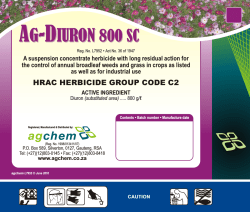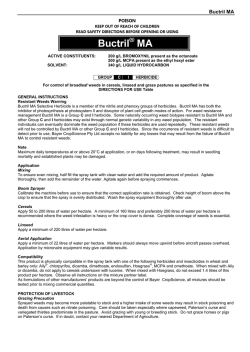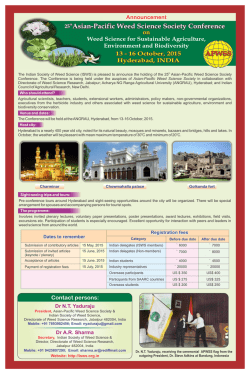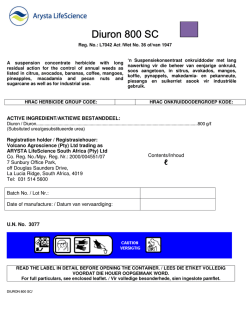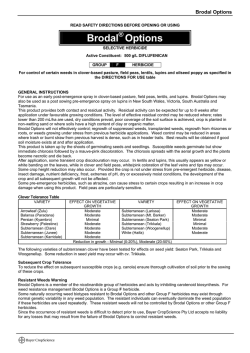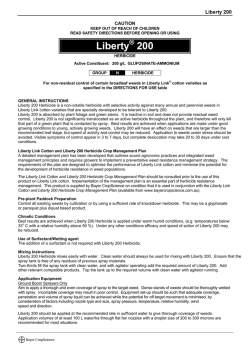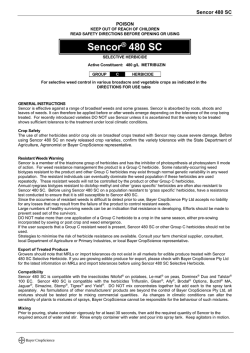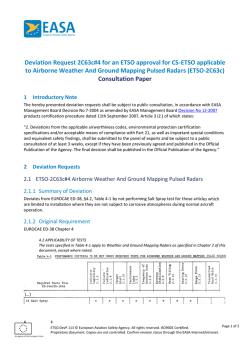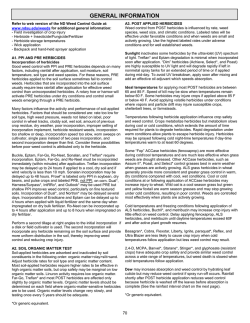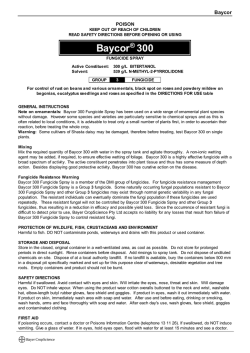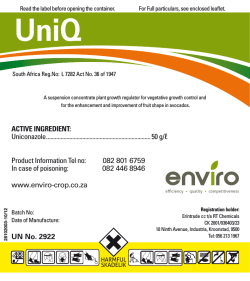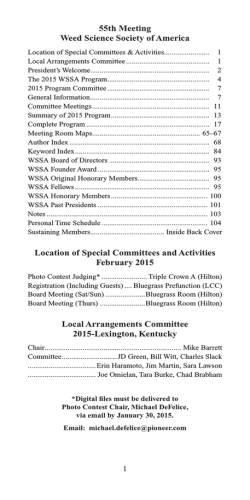
Basta web label - Bayer CropScience
Basta CAUTION KEEP OUT OF REACH OF CHILDREN READ SAFETY DIRECTIONS BEFORE OPENING OR USING Basta® NON-SELECTIVE HERBICIDE Active Constituent: 200 g/L GLUFOSINATE-AMMONIUM GROUP N HERBICIDE For non-residual control of broadleaf and grass weeds in various situations as specified in the DIRECTIONS FOR USE table GENERAL INSTRUCTIONS Basta is a non-volatile herbicide with non-selective activity against many annual and perennial broadleaf weeds and grasses. Basta is absorbed by plant foliage and green stems. It is not significantly translocated as an active herbicide throughout the plant, and therefore will only kill that part of a green plant that is contacted by spray. Basta does not provide residual weed control. Visible symptoms of control appear in 3 to 7 days, but complete desiccation may take 20 to 30 days under cool conditions. Best results are achieved when application is made under good growing conditions. Application to weeds under stress (e.g. due to continuous severe frosts, dry or waterlogged conditions) should be avoided. Soil fumigation / sterilisation Basta is metabolised (broken down) by microorganisms in the soil to become inactive. Soil fumigation or sterilisation will reduce the number of microorganisms present, thus slowing the breakdown of Basta. As damage to transplants or seedlings may occur, it is not advisable to apply Basta in conjunction with soil fumigation or sterilisation. Plastic mulches Basta will remain active on inert surfaces such as plastic. Special care should be taken when applying Basta over plastic mulches, as plant contact with the mulch after spraying may result in crop damage. Resistant Weeds Warning Basta Non-Selective Herbicide is a member of the phosphinic acid group of herbicides. Basta is an inhibitor of glutamine synthetase. For weed resistance management Basta is a Group N herbicide. Some naturally occurring weed biotypes resistant to Basta and other Group N herbicides may exist through normal genetic variability in any weed population. The resistant individuals can eventually dominate the weed population if these herbicides are used repeatedly. These resistant weeds will not be controlled by Basta or other Group N herbicides. Since occurrence of resistant weeds is difficult to detect prior to use, Bayer CropScience Pty. Ltd. accepts no liability for any losses that may result from the failure of Basta to control resistant weeds. Export of Treated Produce Growers should note that suitable MRLs or import tolerances may not be established in all markets for produce treated with Basta Non-Selective Herbicide. If you are growing produce for export, please check with Bayer CropScience Pty. Ltd. for the latest information on MRLs and import tolerances BEFORE using Basta Non-Selective Herbicide. Compatibility Basta is compatible with most residual herbicides e.g. simazine, diuron, oxyfluorfen (Goal®), norfluazuron (Solicam®) and oryzalin (Surflan®), and with glyphosate and metsulfuron-methyl. The addition of a wetting agent or other adjuvant is generally not considered necessary, with the exception of the required addition of an adjuvant to assist in control of Pinus spp. (refer to the Directions for Use table). However, benefit has been obtained using a wetting agent or adjuvant on hard-to-wet weeds when using water rates in excess of 500 L/ha. The rate is 25 mL/100 L of a 1000 g/L non-ionic wetting agent, or equivalent. For further information on suitable adjuvants, and compatibility with insecticides and other herbicides contact your local Bayer CropScience representative. Mixing Basta mixes easily with water. Clean water should always be used for mixing with Basta. Ensure that the spray tank is free of any residues of previous spray materials. Two-thirds fill the spray tank with clean water, and with agitator operating add the required amount of Basta. Add other relevant compatible products. Top the tank up to the required volume with clean water with agitator running. Basta Application A. Orchards, plantations, vineyards and other row crops and B. Commercial, industrial, non-agricultural areas and forestry plantations Apply by ground spraying equipment only. Aim to apply a thorough and even coverage of spray to the target plant. Dense stands of weeds should be thoroughly wetted with spray. Incomplete coverage may result in poor control. Equipment set-up should be such that adequate coverage, penetration and volume of spray liquid can be achieved while the potential for off-target movement is minimised. Boom or Directed Sprayer Equipment Basta should be applied at label rates (refer to specific column in the list of weeds controlled) in sufficient water to give thorough coverage of weeds. It has been found that 300 to 500 L/ha has given good results under most weed conditions. Special care must be taken when using sprayer/slasher combination units not to cause dust and turbulence, which can carry spray into non-target areas. Knapsack and Handgun Equipment Basta should be applied at label rates (refer to specific columns in the list of weeds controlled) in adequate water to thoroughly wet the weeds being sprayed, i.e. 500 to 1000 L/ha. Dense stands will require up to 1000 L/ha of spray mixture, whereas less dense stands will require less water. High volume application using hollow-cone nozzles for hand spraying is recommended. Controlled Droplet Application (CDA) Equipment Basta may be applied through CDA row spraying equipment fitted with a solid (impermeable) shroud or skirt, at rates as recommended for boom or directed sprayers (Refer to specific column in the list of weeds controlled), provided thorough spray coverage of weeds can be achieved. Apply preferably when weeds are less than 15 cm in height, with the equipment set up so that the spray dome only just touches the tops of the weeds. A total spray volume of 20 to 30 L/ha has been found to give good results. Do not mix residual herbicides or any spray adjuvants with Basta when using CDA equipment. Warning: Because the spray solution is highly concentrated particular care must be taken when using Basta through CDA equipment to avoid contact of the spray solution with any part of the crop trunk or canopy. DO NOT apply Basta through equipment fitted with bristle skirts. Particular care should be taken when using CDA equipment around green or uncalloused bark. Please refer to PROTECTION OF CROPS, NATIVE AND OTHER NON-TARGET PLANTS. CDA equipment must not be used for application in cherry orchards. C. Summer fallow situations Apply by ground spraying equipment only. Aim to apply a thorough and even coverage of spray to the target weed. Incomplete coverage may result in poor control. Equipment set-up should be such that adequate coverage, penetration and volume of spray liquid can be achieved while the potential for off-target movement is minimised. Basta should be applied at the recommended rate in sufficient water to give thorough coverage of weeds. Application volumes of at least 100 L /ha through nozzles that will deliver a MEDIUM spray droplet as defined by ASABE S572 Standard or BCPC Guideline are recommended. Sprayer cleanup Clean all equipment after use by thoroughly flushing with water. PRECAUTIONS Re-entry Period Do not allow entry into treated areas until the spray has dried. When prior entry is necessary, wear cotton overalls buttoned to the neck and wrist (or equivalent clothing) and chemical resistant gloves. Clothing must be laundered after each day’s use. PROTECTION OF WILDLIFE, FISH, CRUSTACEANS AND ENVIRONMENT DO NOT contaminate streams, rivers or waterways with this product or the used container. PROTECTION OF CROPS, NATIVE AND OTHER NON-TARGET PLANTS DO NOT apply under weather conditions, or from spraying equipment, that may cause spray to drift onto nearby susceptible plants/crops, cropping lands or pastures. DO NOT apply on desirable foliage or allow spray to drift onto the foliage of desirable plants, trees or vines, as damage will occur. DO NOT allow product to contact green or uncalloused bark (such as on desirable young trees and vines) or cut, cracked, damaged or wounded tissue, where the affected surface is not adequately healed. Basta may be used around desirable trees/vines less than two years old provided they are effectively shielded from spray and spray drift. DO NOT allow desirable plant foliage to contact any inert surface, such as plastic mulches, which have been treated with Basta. DO NOT apply Basta to recently fumigated or sterilised soil. Basta STORAGE AND DISPOSAL Store in the closed, original container in a cool, well-ventilated area. Do not store for prolonged periods in direct sunlight. The method of disposal of the container depends on the container type. Read the ‘STORAGE AND DISPOSAL’ instructions on the label that is attached to the container. SAFETY DIRECTIONS Harmful if absorbed by skin contact or swallowed. Will irritate the eyes and skin. Avoid contact with the eyes and skin. If product on skin, immediately wash area with soap and water. If product in eyes, wash out immediately with water. When opening the container, preparing spray and using the prepared spray, wear cotton overalls buttoned to the neck and wrist (or equivalent clothing) and a washable hat, elbow length PVC or nitrile gloves and face shield or goggles. Wash hands after use. After each day’s use, wash gloves, face shield or goggles, and contaminated clothing. FIRST AID If poisoning occurs, contact a doctor or Poisons Information Centre (telephone 13 11 26). MATERIAL SAFETY DATA SHEET Additional information is listed in the Material Safety Data Sheet, which can be obtained from www.bayercropscience.com.au. EXCLUSION OF LIABILITY This product must be used strictly as directed, and in accordance with all instructions appearing on the label and in other reference material. So far as it is lawfully able to do so, Bayer CropScience Pty Ltd accepts no liability or responsibility for loss or damage arising from failure to follow such directions and instructions. Basta® is a Registered Trademark of Bayer. APVMA Approval No.: 39118/54519 FOR 24 HOUR SPECIALIST ADVICE IN EMERGENCY ONLY PHONE 1800 033 111 Basta DIRECTIONS FOR USE RESTRAINTS DO NOT apply with aircraft. DO NOT apply when rain is expected within 6 hours. DO NOT apply to weeds under stress due to, for example, very dry, very wet, frosty or diseased conditions. A. ORCHARDS, PLANTATIONS, VINEYARDS and OTHER ROW CROPS CROP/ SITUATION Blackberry, boysenberry, loganberry, raspberry Avocado, banana, feijoa, guava, kiwifruit, litchi, mango, pawpaw, passionfruit, pineapple, rambutan plantations Citrus orchards Olive plantations Pome and stone fruit orchards Tree nut plantations Vineyards WEEDS STATE RATE WHP Nil Primocane and sucker control NSW, ACT, Vic, Tas only 500 mL /100 L water See list of weeds controlled in Table 1. Qld, NSW, ACT, Vic, SA, WA, NT only 1.0 to 5.0 L/ha CRITICAL COMMENTS Apply as a directed spray to suckers and primocanes. Contact with flowers, developing fruit or desirable foliage will cause damage. Ensure complete coverage of primocanes/suckers by spraying to the point of runoff, preferably when they are less than 15 cm high. A non-ionic wetting agent (1000 g/L) may be added at a rate of 25 mL/100 L or equivalent. Apply as a directed or shielded spray. Refer to the label section Application for specific information on application methods. Warnings: Do not allow spray or spray drift to contact desirable foliage or green (uncalloused) bark. To avoid potential crop damage, refer to the label sections on Application and PROTECTION OF CROPS, NATIVE AND OTHER NON-TARGET PLANTS. Controlled Droplet Application equipment must not be used for application in cherry orchards. Basta may be used around trees/vines less than two years old provided they are effectively shielded from spray and spray drift. All States 21 days (H) The recommended rate of use is determined by the following criteria: WEED SPECIES WEED STAGE OF GROWTH WEED DENSITY CLIMATIC CONDITIONS Nil WEED SPECIES Apply the appropriate rate to control the least susceptible weed present as per the lists of weeds controlled in the accompanying tables. WEED STAGE OF GROWTH Use the lower rate when weeds are young and succulent (grasses: pre-tillering; broadleaves: cotyledons to 4-leaf) or the population is very sparse. A median rate should be used for medium sized plants (grasses: tillering; broadleaves: 4 leaf to advanced vegetative) and the high rate should be used when weeds are mature (grasses: noding to flowering; broadleaves: budding to flowering). WEED DENSITY Use the higher rates when the weed population is dense. Thorough coverage of weeds is essential for good control. CLIMATIC CONDITIONS Best results are achieved when applied under warm humid conditions (temperatures below 33o C with a relative humidity above 50 %). Control will be reduced and/or slower under cold conditions. Good results will be achieved under most other conditions, however poor results may occur under hot, dry conditions. Weeds that have been hardened or stunted in growth due to stressed conditions should be treated at the maximum rate. COVERAGE Complete coverage of weeds is essential for good control. Poor coverage may result in re-growth. PERENNIAL WEEDS Apply when weeds are actively growing. Follow up treatments will be necessary to control re-growth of perennial weeds in most cases. Basta Strawberries, cane berry fruits (inter-row) Tomatoes (inter-row) See list of weeds controlled in Table 1. All States 1.0 to 5.0 L/ha Nil Apply as a directed or shielded spray to the inter-row area. Take care not to allow spray or spray drift to contact the crop, including strawberry runners. Refer to GENERAL INSTRUCTIONS for warnings concerning plastic mulch and fumigated/sterilised soil. Determine the recommended rate of use by considering the criteria WEED SPECIES, WEED STAGE OF GROWTH, WEED DENSITY and CLIMATIC CONDITIONS, as described above. B. COMMERCIAL, INDUSTRIAL, NON-AGRICULTURAL AREAS and FORESTRY PLANTATIONS CROP/ SITUATION Commercial & industrial areas, forest plantations, rights-of-way and other nonagricultural areas Commercial & industrial areas, forest plantations, rights-of-way and other nonagricultural areas Forestry plantations (preplant plantation establishment) WEEDS See list of weeds controlled in Table 1. Volunteer or wildling Pinus spp. STATE All States All States RATE 1.0 to 5.0 L/ha WHP CRITICAL COMMENTS - Determine the recommended rate of use by considering the criteria WEED SPECIES, WEED STAGE OF GROWTH, WEED DENSITY and CLIMATIC CONDITIONS as described above in Part A of the Directions for Use table. Warnings: Do not allow spray or spray drift to contact desirable plants. To avoid potential crop damage, refer to the label sections on Application and PROTECTION OF CROPS, NATIVE AND OTHER NON-TARGET PLANTS. Basta is a non-selective herbicide and will affect most weeds. Its forestry use is designed to improve the control of Pinus spp. wildings when pre-plant weed control is carried out. To broaden the weed spectrum, mixing with other herbicides such as glyphosate and metsulfuron-methyl at labelled rates may be necessary. Handgun and knapsack application 500 mL/ 100 L water APPLICATION Apply with an adjuvant. The addition of an adjuvant e.g. NuFilm® P or Exit® may assist in improving performance. High water volumes or nozzle systems should be used to achieve complete coverage of weeds, which is essential for good control. Handgun and knapsack rates are based on the application of 1000 L of spray mixture per sprayed hectare. This is usually adequate to thoroughly wet dense stands of weeds. Less dense stands will require lower water rates. Basta does not provide residual weed control. Refer also to comments in the General Instructions which relate to application. 5 L /ha WEED GROWTH STAGE AND CONDITION Use on Pinus spp. ≤ 15 cm is recommended to maximise efficacy. Apply when weeds are actively growing. Results will be reduced if treated plant is under stress due to very dry, very wet, frosty or diseased conditions. COVERAGE Complete coverage of target is essential for good control. Poor coverage may result in re-growth. CLIMATIC CONDITIONS Best results are achieved when applied under warm, humid conditions (temperatures below 33o C with a relative humidity above 50 %). Good results will be achieved under most other conditions, however poor results may occur under hot, dry conditions. Trials have shown better results from autumn and winter applications than from spring and summer applications. Line-marking on sports grounds Turf grasses and other weeds All States 250 to 500 mL /100 L water - SYMPTOMS Visible symptoms will appear within 3 weeks; tree death may take several months depending on initial coverage and size of tree. Follow up treatments may be necessary to control regrowth in some cases. Refer to General Instructions. Basta is a non-selective, non-residual herbicide with limited translocation potential. It is therefore ideally suited for linemarking on sports fields where precise weed control is required. Apply at 6 – 8 week intervals depending on growth of turf. Apply using single boom or hand wand. Basta C. SUMMER FALLOW SITUATIONS CROP/ SITUATION Maintenance of summer fallow prior to planting; Cereal grains (including wheat, barley, oats, maize and sorghum) Pulses (including chickpeas, faba beans, field peas, lentils, lupins and mungbeans), Oilseeds (including canola, cotton, soybeans and sunflowers) Do not sow crops until 14 days or more have elapsed after the final application. WEEDS Control of: Annual polymeria Bellvine Bladder ketmia Caltrop Dwarf amaranth Field bindweed (European bindweed) Flax-leaf fleabane Paddy melon Peach vine Red pigweed Rhyncho (Rhyncosia) Sesbania pea Sowthistle (Milk thistle) Volunteer cotton (other than Liberty Link cotton) Yellow vine Suppression of: Chinese lantern (Wild gooseberry) Noogoora burr complex WEED STAGE 2-6 leaf RATE 3.75 L/ ha in a minimum of 100 L water CRITICAL COMMENTS Apply to actively growing weeds. Good coverage is essential. Refer ‘Application’ section for details. Do not apply more than three applications per season. Basta will have an effect on weeds that are larger than the recommended leaf stage, but speed of activity and level of control may be reduced. CLIMATIC CONDITIONS Best results are achieved when Basta is applied under warm humid conditions (temperatures below 33o C with a relative humidity above 50 %). Under any other conditions efficacy and speed of action may be reduced. Do not apply onto weeds when dew, fog or mist is present. NOT TO BE USED FOR ANY PURPOSE, OR IN ANY MANNER, CONTRARY TO THIS LABEL UNLESS AUTHORISED UNDER APPROPRIATE LEGISLATION. WITHHOLDING PERIODS (WHP) Harvest (H) Avocado, banana, blackberry, boysenberry, citrus fruit, feijoa, grapes, guava, kiwifruit, litchi, loganberry, mango, olives, passionfruit, pawpaw, pineapple, rambutan, raspberry, strawberries, tomatoes, tree nuts: NOT REQUIRED WHEN USED AS DIRECTED. Pome and stone fruit: DO NOT HARVEST FOR 21 DAYS AFTER APPLICATION. Grazing (G) DO NOT GRAZE OR CUT TREATED AREAS FOR STOCK FOOD FOR 8 WEEKS AFTER APPLICATION. Summer fallow: DO NOT GRAZE OR CUT FOR STOCKFOOD A CROP SOWN FOLLOWING A FALLOW SPRAY FOR 6 WEEKS AFTER SOWING Basta Table 1: List of weeds controlled with recommended application rate. Boom or directed sprayer L/ha APPLICATION RATE Handgun Knapsack mL/100 L mL/15 L COMMON NAME SCIENTIFIC NAME Amaranthus spp. Apple of Peru Argentine peppercress Awnless barnyard grass Barley grass Barnyard grass Billy goat weed Bitter cress Black bindweed (buckwheat) ANNUAL WEEDS Amaranthus spp. Nicandra physalodes Lepidium bonariense Echinochloa colona Hordeum leporinum Echinochloa crus galli Ageratum conyzoides Cardamine hirsuta Fallopia convolvulus 2.0 to 5.0 1.5 to 3.0 2.0 to 3.0 2.5 to 3.5 2.0 to 3.0 2.0 to 5.0 2.0 to 5.0 2.0 to 5.0 1.8 to 5.0 500 300 300 350 300 500 500 500 500 75 45 45 53 45 75 75 75 75 Hibiscus trionum Entolasia marginata Bromus spp. Calopogonium mucunoides Tribulus terrestris Arctotheca calendula Trifolium subterraneum Bidens pilosa Erodium cicutarium Eleusine indica Lamium amplexicaule Chenopodium pumilo Chenopodium album Conyza bonariensis Fumaria officinalis Chenopodium carinatum Phalaris minor Urochloa panicoides Medicago spp. Sonchus oleraceus Salvia reflexa Tetragonia tetragoniodes Echium plantagineum Arachis hypogaea Portulaca oleracea Urena lobata Galinsoga parviflora Bromus unioloides1 Lactuca serriola Rhynchelytrum repens Lolium rigidum Carthamus lanatus Centaurea solstitialis Plantago cunninghamii Anagallis arvensis Setaria italica Carduus tenuiflorus Vulpia myuros Sorghum bicolor Spermacoce latifolia Stachys arvensis Ipomoea quamoclit Digitaria ciliaris Crassocephalum crepidioides Emex australis Lycopersicon esculentum Stylosanthes humilis Rapistrum rugosum Silybum marianum Triticum aestivum Daucus glochidiatus 3.0 to 5.0 2.0 to 4.0 2.0 to 3.0 2.0 to 5.0 3.0 to 5.0 1.5 to 5.0 1.8 to 3.0 2.0 to 5.0 1.5 to 4.0 3.0 to 5.0 2.0 to 5.0 3.0 to 5.0 3.0 to 5.0 3.0 to 5.0 1.8 to 5.0 2.0 to 5.0 3.0 to 5.0 1.5 to 5.0 1.0 to 5.0 2.0 to 5.0 3.0 to 5.0 2.0 to 5.0 1.0 to 3.0 1.5 to 3.0 3.0 to 5.0 2.0 to 5.0 2.0 to 5.0 4.0 to 5.0 3.0 to 5.0 2.0 to 5.0 2.0 to 5.0 1.5 to 5.0 1.5 to 5.0 2.0 to 3.0 2.0 to 5.0 2.0 to 5.0 2.5 to 5.0 2.0 to 5.0 2.0 to 5.0 2.0 to 5.0 2.0 to 5.0 2.0 to 5.0 2.0 to 5.0 3.0 to 5.0 2.0 to 5.0 2.0 to 5.0 1.0 to 3.0 3.0 to 5.0 2.5 to 5.0 4.0 to 5.0 2.0 to 5.0 500 400 300 500 500 500 300 500 400 500 500 500 500 500 500 500 500 500 500 500 500 500 300 300 500 500 500 500 500 500 500 500 500 300 500 500 500 500 500 500 500 500 500 500 500 500 300 500 500 500 500 75 60 45 75 75 75 45 75 60 75 75 75 75 75 75 75 75 75 75 75 75 75 45 45 75 75 75 75 75 75 75 75 75 45 75 75 75 75 75 75 75 75 75 75 75 75 45 75 75 75 75 (refer Note 2) Bladder ketmia Bordered panic Brome grasses (refer Note 1) Calopo Caltrop burr Cape weed Clover (subterranean) Cobbler’s peg Common storksbill Crowsfoot grass Dead nettle Dwarf crumbweed Fat hen Flax-leaf fleabane Fumitory Green crumbweed Lesser canary grass Liverseed grass Medics (annual) Milk thistle Mint weed New Zealand spinach Patterson’s curse Peanuts Pigweed Pinkburr Potato weed Prairie grass (refer Note 1) Prickly lettuce Red natal grass Ryegrass (annual) Saffron thistle St. Barnaby’s thistle Sago weed Scarlet pimpernel Setaria Sheep thistle Silver grass Sorghum/sudax Square weed Stagger weed Star of Bethlehem Summer grass Thickhead Three cornered jack Tomato Townsville stylo Turnip weed Variegated thistle Wheat Wild carrot Basta COMMON NAME SCIENTIFIC NAME Wild gooseberry Wild mustard Wild oats Wild radish Wire weed Physalis minima Sysimbrium orientale Avena spp. Raphanus raphanistrum Polygonum aviculare PERENNIAL WEEDS Imperata cylindrica Homeria spp. Centrosema pubescens Glycine latrobeana Cynodon dactylon Vigna unguiculata Mimosa invisa Desmodium intortum Sorghum halepense Panicum spp. Paspalum spp. Convolvulus arvensis Oxalis corymbosa Sida retusa Desmodium uncinatum Macroptilium atropurpureum Eragrostis cilianensis Trifolium repens Richardia brasiliensis Epilobium spp. Blady grass Cape tulip Centro Clover glycine Couch grass Cow pea Giant sensitive plant Greenleaf desmodium Johnson grass Panicum spp. Paspalum spp. Perennial bindweed Shamrock Sida weed Silver leaf desmodium Siratro Stink grass White clover White eye Willow herb Boom or directed sprayer L/ha 2.0 to 5.0 2.0 to 5.0 3.0 to 5.0 5.0 1.5 to 5.0 3.0 to 4.0 2.0 to 3.0 1.0 to 5.0 1.0 to 3.0 2.5 to 5.0 1.0 to 3.0 2.0 to 5.0 1.0 to 3.0 3.0 to 5.0 2.0 to 5.0 3.0 to 5.0 2.0 to 3.0 3.0 3.0 to 5.0 4.0 to 5.0 1.0 to 3.0 3.0 to 5.0 3.0 to 5.0 3.0 to 5.0 4.0 to 5.0 APPLICATION RATE Handgun Knapsack mL/100 L mL/15 L 500 500 500 500 500 75 75 75 75 75 400 300 500 300 500 300 500 300 500 500 500 300 300 500 500 300 500 500 500 500 60 45 75 45 75 45 75 45 75 75 75 45 45 75 75 45 75 75 75 75 Notes: 1. Well-established clumps of prairie grass and brome grasses may only be suppressed at these rates. Follow-up treatments may be necessary to control regrowth. 2. Good control will be achieved on small and medium sized plants only in non-crop situation.
© Copyright 2025
